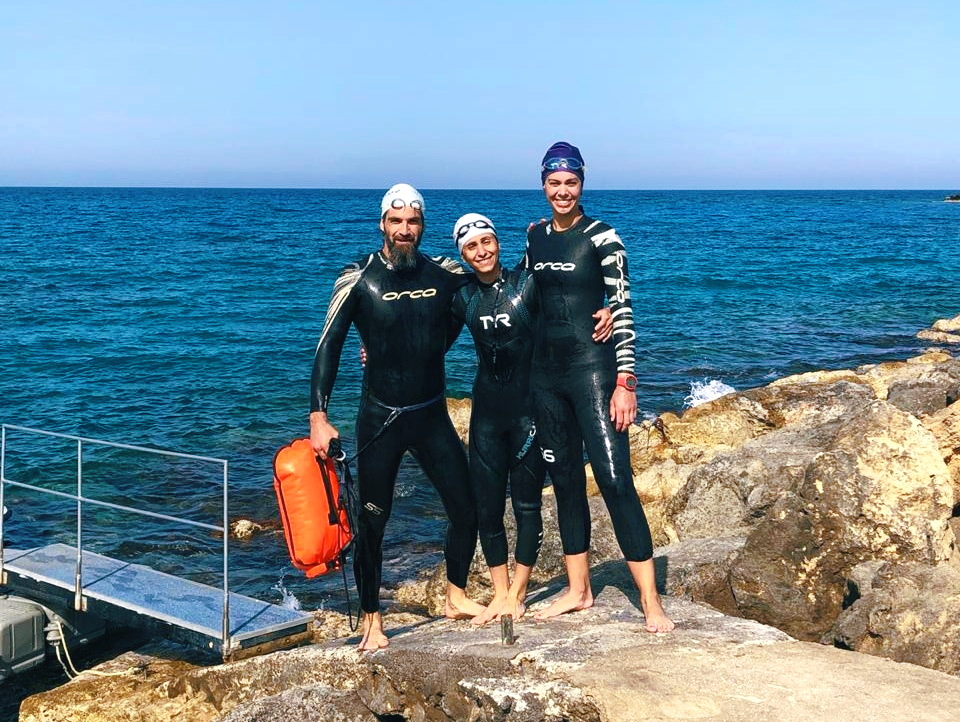Open water swimming one of the most enjoyable experiences there is. It touches on all the senses: from seeing the different colors of the water from far when driving down, to hearing the sound of the waves, feeling the cooling sensations on your skin when going in, to observing whatever is happening under the water, tasting and smelling the salty water, to the slight happy lightheadedness upon leaving the water.
As members of Nireas Triathlon Club, we organize informal open water swims, as well as structured open water training sessions on a regular basis. We use the dedicated Nireas Triathlon Club Whatsapp swimming group. Any member who likes to organize a swimming related event, is invited to propose an activity to all members.
Anyone who is interested to join the activity and has the skill and physical condition to participate, is welcome, by confirming their attendance. Guests are very welcome, as long as they are aware of and subscribe to these Nireas Triathlon Club Open Water Swimming Guidelines.
With the aim to keep all of us safe and to ensure an enjoyable workout for everyone in the big blue, we have gathered the best practices in open water swimming. And captured them in these Nireas Triathlon Club Open Water Swimming Safety and Communications guidelines. This document serves as a guideline for all members who organize or participate in Nireas Triathlon Club Open Water swimming events. And of course, when you are out at your own leisure, use these to your advantages as well!
We wish you amazing open water swimming experiences,
Nireas Triathlon Club Board
Open Water Swim Organization & Responsibilities
ORGANIZE THE SWIM
The person who organizes the swim, communicates in Whatsapp and email, inviting the members. This communication includes:
- Time
- Meeting point
- Planned approximate distance and route
- Expected weather conditions (wind, waves, temperature)
- Any group plans before or after swimming
- Team members to confirm their participation in email or WhatsApp
PREPARE TO SWIM – ON LOCATION
Swim organizer checks if all participants are present
Ensure one leader is appointed and that all know who this is (this does not have to be theperson organizing the swim)
At least one person should be familiar with the area or get the information from a local
Final check on conditions and lead to change plan if necessary
Lead to brief all participants about route, planned distance and stopping points on the way
Make sure you have someone ashore who knows where you are going, how many you are and what the estimated time is that you will be back
Preferably swim against the wind direction first and have the wind (if any) supporting you on the way back
If you are not sure whether to swim (for any reason, like you are not feeling well), stay ashore
DURING THE SWIM
All go in the water together
Swim lead to be aware at all times of position and status of swimmers in the group
Group to stay together as much as possible
Split into smaller groups at the same pace if required
Buddy up with someone at similar pace and endurance levels
No swimmer to leave the group without informing the lead
If you are not feeling well during the swim, inform the lead and agree upon what to do
Swim as close to the shore as possible
Stay calm if you accidentally enter a rip current, best is to swim diagonally to get out
Swim inside marked areas when available (be aware of “drifting” outside the area)
AFTER THE SWIM
Inform the person ashore that you are back
Lead to evaluate experience with all participants. Identify any improvements for the next session
Enjoy a well deserved coffee and/ or mahalepi!
Open Water Swimming Safety Guidelines
BE VISIBLE
Visibility in the water is key, no matter what time of the year, no matter what conditions.
Other users of the water may or may not see you as well as you see them.
Wear a bright colored swimming cap (orange, white, the Nireas caps are great for this).
Swim with a swimming buoy (some of them are also a dry bag and can carry small items).
BE AWARE OF YOUR SURROUNDINGS
Make sure you have an understanding of the area:
- Boats (anchored and moving)
- Jet-ski’s
- Buoys
- Other swimmers
- Rocks
- Visible reefs
- Landmarks
- Fishing nets
Get and keep a feel for the environment. Keep your ears open for the sounds of motor boats. Sight regularly whilst swimming. Stay with the group. Keep an eye on your fellow swimmers in the group.
BE AWARE OF TIME OF DAY AND CHANGING CONDITIONS
Swim during daylight hours. Avoid swimming at sunrise and sunset. When the sun is low, close to the horizon, others on the water (notably speedboats and jet-ski’s) will not be able to see you, even when you are wearing highly visible gear.
Also keep an eye on the clouds, thunderstorms can roll in quickly. In case of rapidly changing and deteriorating weather conditions, especially thunderstorms, return to shore immediately.
IMPORTANT NOTE
As an individual, you are always responsible for your own safety and well-being.
If you don’t feel well before a swim, consider staying ashore.
In case you don’t feel well during the swim, notify the lead and agree upon the best way forward.
What to bring to an open water swim
- A bright colored swimming cap
- A swim buoy (if you have)
- Sun protection
- Fins/ paddles / snorkel if you want to (especially for slower swimmers)
- Water
- Wetsuit (depending on conditions and personal preference)
- Vaseline/ Glide if you use a wetsuit

